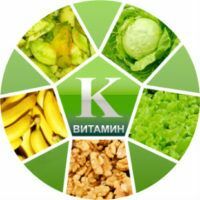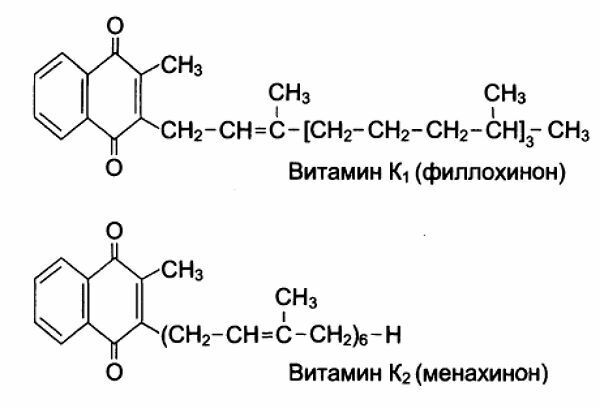
The name of vitamin K comes from the first letter of the word "coagulation"( blood coagulation).With normal nutrition in healthy people, hypovitaminosis K is not observed, so this vitamin is usually of little importance. But fame does not always reflect the importance, and the importance of vitamin K on the basis of its participation in the processes of blood coagulability is unquestionable.
Vitamin K value
Vitamin( or rather hormone) Vitamin K is a group of structurally similar fat-soluble vitamins, essential for the normal functioning of the human body.
By vitamin K we mean two natural vitamins: K1( phylloquinone) and K2( menaquinone).Under vitamin K2, in turn, is understood several chemical subtypes, with different length of carbon chains.

Vitamin K1 is produced by plants, and is found in large quantities in green leafy vegetables, because it takes a direct part in photosynthesis. Phylloquinone is considered as a plant form of vitamin K, and bacteria in the intestine transform phylloquinone into a number of forms of menaquinone.
The synthetic form of the vitamin( K3, menadione) can be toxic because it interacts with the functions of protecting the cell from free radicals of the glutathione tripeptide, and is no longer used to treat hypovitaminosis K.
to the table of contents ^Daily requirement of
With a vitamin K dosage usuallyThe difference between K1 and K2 is not carried out. The daily adequate level of vitamin K intake is 90 μg for adult women( including pregnant and lactating women) and 120 μg for men.
For children under 1 year of age, adequate intake is 2-2.5 μg, and at ages 1 to 18 years, gradually increases from 30 to 75 μg. In the case of taking vitamin K in large quantities there is no evidence of adverse effects, and the maximum daily intake is not established, but consumption up to 360 μg is considered safe.
to contents ^Useful properties
Fat-soluble vitamin K:
- is involved in blood clotting and protein synthesis;
- affects the condition of bone tissue by regulating the binding of calcium;
- is an antioxidant, counteracts the harmful effects of free radicals;
- in women after menopause reduces the risk of bone fracture( protects against osteoporosis);
- has antibacterial and analgesic effect, promotes wound healing.
Indications for admission
Often it is recommended to take it in the following cases:
- liver disease( hepatitis and cirrhosis);
- tuberculosis with pulmonary hemorrhage;
- dysproteinemia( disruption of normal correlation between blood protein fractions);
- protracted diarrhea;
- pregnancy( to prevent and prevent the death of newborns from bleeding);
- hemorrhage of newborns;
- bleeding prevention in preparation for surgery;
- bleeding after wounds and in the postoperative period;
- blood sepsis with internal bleeding;
- obstructive( mechanical) jaundice;
- uterine bleeding;
- bleeding with peptic ulcer and other intestinal diseases;
- muscle weakness;
- bleeding as a consequence of radiation sickness;
- bleeding after an overdose of anticoagulants and some other medications;
- atony( decreased peristalsis) of the intestine;
- increased vascular fragility;
- poisoning with coumarin( found in spoiled food).
Content in products
The main sources of vitamin K are green leafy vegetables, cabbage, some fruits, pine nuts. The most valuable is the vitamin content in vegetables, because it is combined with their low calorie content. The table shows the vitamin K content for the most vitamin-rich sources.
| Product | content of vitamin K, g / 100 g |
|---|---|
| Tea Leaves Green Tea | 960 |
| Spinach | 460 |
| Cabbage | 450 |
| Tomatoes | 400 |
| Green peas | 340 |
| Tea leaves of black tea | 340 |
| Soybeans | 240 |
| Broccoli | 210 |
| Soybean oil | 200 |
| Chives | 190 |
| Olive oil | 170 |
| Strawberry | 130 |
| Meat | 110-160 |
| Fish | 110 |
| Horseradish, parsley | 100 |
For other vegetables, nuts, eggs, fruits and dairy products, the vitamin content is below 100 μg / 100 g.
to contents ^Symptoms of deficiency
Vitamin K deficiency leads to the development of hemorrhagic syndrome( increased vascular bleeding, which leads to intradermal and subcutaneous hemorrhages, gum bleeding, nasal and gastric bleeding).In view of the high content of vitamin in foods, the food factor is not the cause of hypovitaminosis( a typical diet already contains 300-500 μg of vitamin K).
The risk group for hypovitaminosis K( as well as for vitamin D) includes people with chronic kidney disease. It is possible that hypovitaminosis K is one of the causes of male infertility caused by insufficient mobility of spermatozoa. Lack of vitamin K is also observed in the elderly. The cause of hypovitaminosis may be:
- dysbacteriosis( violation of the microflora) of the intestine after treatment with antibiotics or sulfonamides( taking broad-spectrum antibiotics leads to a decrease in the production of vitamin K in the intestine fourfold in comparison with healthy people);
- poisoning with antivitamins K( coumarin and others);
- pathology of the liver and biliary tract, which leads to a deficiency necessary for the assimilation of vitamin bile acids. The deficiency of vitamin K is manifested by the following symptoms:
- wounds bleed for a long time and poorly heal;
- bleeds the gums;
- nasal bleeding;
- bleeding in the gastrointestinal tract;
- subcutaneous hemorrhage;
- hypoprothrombinemia( a deficiency in the blood of the prothrombin clotting factor);
- weakness and rapid fatigue;
- painful menstruation.
Benefits and use of vitamin E at home http://woman-l.ru/polza-i-primenenie-vitamina-e/loading. ..
back to contents ^
Symptoms of overdose
Vitamin K is not toxic even with an overdose, but sinceit increases blood coagulability, overdose is unacceptable in certain diseases and conditions. With an overdose, the following symptoms are possible:
- nausea;
- headache;
- diarrhea;
- skin dryness;
- spontaneous abortion and fetal malformations in pregnant women are possible.
Harm and contraindications to
Although allergic reactions to vitamin K intake are possible, there is no clear evidence of the toxicity of high doses of phylloquinone and menaquinone, and the maximum tolerable intake is not established.
Unlike the safe natural forms of vitamins K1, K2 and their isomers, the synthetic form of the vitamin( K3, menadione) is toxic in large doses. This form is banned for admission by the US Food and Drug Administration because high doses of menadione lead to allergic reactions of the body, hemolytic anemia, and pathological changes in the liver cells.
Explicit contraindications for the intake of vitamin K are:
- increased sensitivity to vitamin;
- embolism;
- thromboses;
- increased blood clotting.
